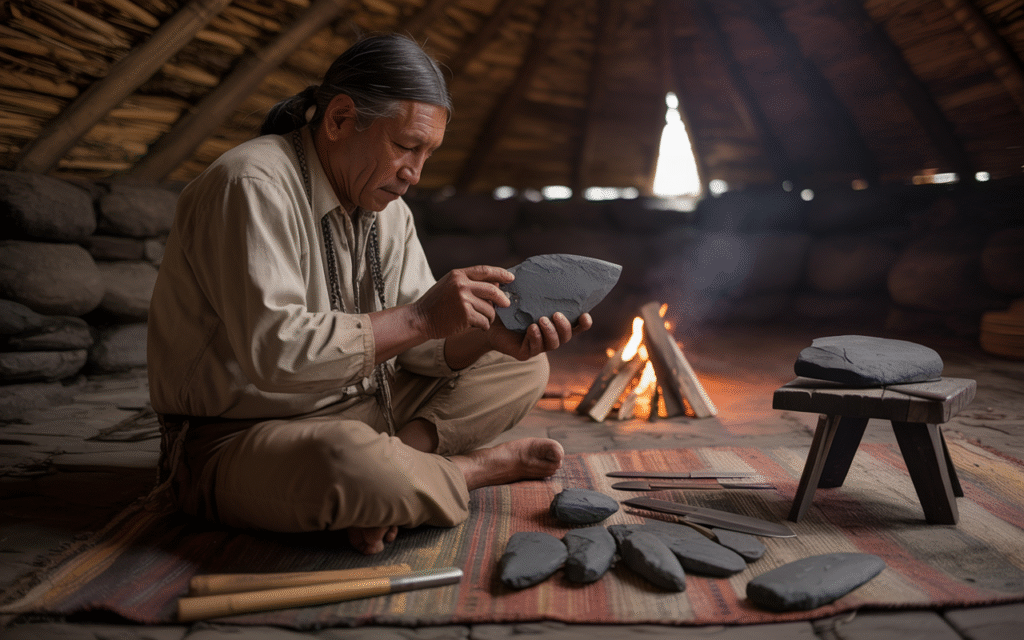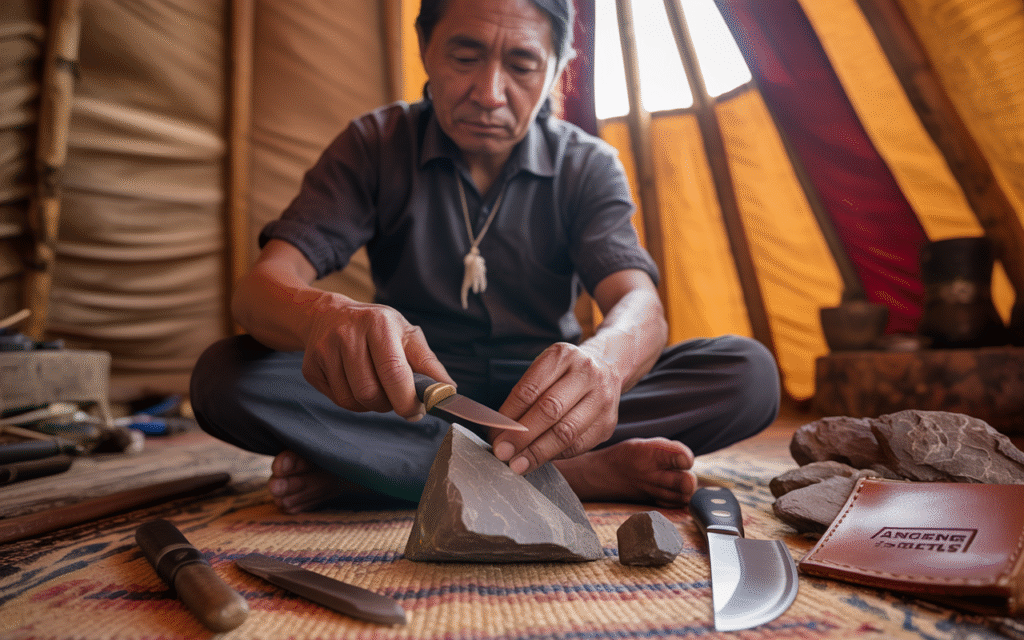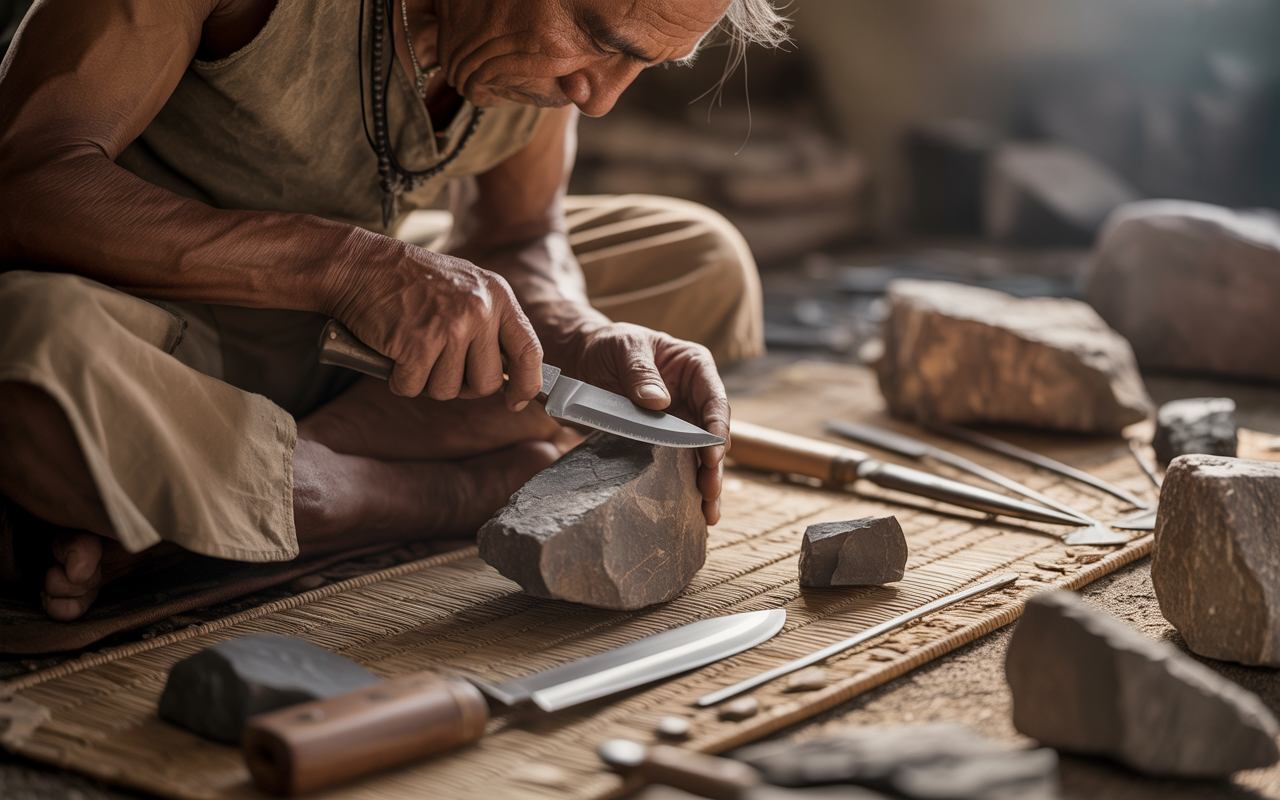Have you ever wondered how people made tools long before metal existed? American Indians found a clever way! They used special rocks from the earth to craft sharp knives. These rocks, called sedimentary rocks, were easy to shape and perfect for cutting. In this article, we’ll explore sedimentary rocks used by American Indians to make knives. We’ll look at the types of rocks, how they turned them into tools, and why these knives mattered so much. Get ready to dive into an exciting story about Native American tools and skills!
What Are Sedimentary Rocks?
First, let’s learn what sedimentary rocks are. These rocks form when tiny bits of dirt, sand, or even old plant pieces pile up over time. Then, pressure squishes them into solid rock. For example, rocks like limestone and sandstone are sedimentary. However, American Indians picked specific sedimentary rocks used by American Indians to make knives because they could break into sharp edges. This breaking style, known as conchoidal fracture, made them ideal for stone knives.
Next, think about why this matters. Sedimentary rocks were all around, so Native Americans could find them easily. Additionally, their sharpness was beneficial for hunting and cooking. Now, let’s see which sedimentary rocks they chose for their amazing tools.
Types of Sedimentary Rocks for Knife-Making
American Indians knew exactly which rocks worked best for knives. They picked sedimentary rocks used by American Indians to make knives based on how sharp and strong they could become. Here are the main ones they used.
Chert: The Star of Stone Tools
Chert was a top choice for sedimentary rocks used by American Indians to make knives. Why? It’s hard and breaks into super-sharp edges. Chert comes in colors like white or gray and was easy to find across North America. Native Americans valued it for its use in making arrowheads and stone knives, as it worked exceptionally well.
Additionally, chert’s toughness made it a crucial component of lithic technology—the science of stone tools. Tribes often traveled great distances to gather the finest chert. It shows how smart they were at picking the right rocks!
Flint: Dark and Dependable
Another great rock was flint. Flint is similar to chert, but it is usually darker, ranging from black to gray. This sedimentary rock used by American Indians to make knives was perfect because it chipped into sharp points, too. Flint showed up in riverbeds and gravel, so it was handy to grab.
Moreover, flint was strong and lasted a long time. Some tribes even traded it with others! Its sharp edges helped with everything from cutting meat to making projectile points.
Obsidian: Sharp as Glass
Now, obsidian isn’t a sedimentary rock—it’s volcanic glass. Still, American Indians used it for knives in some places. Why mention it? Because it’s sharper than anything else, even modern steel! Tribes in the Southwest loved obsidian for stone tool making.
Although it’s different, obsidian worked like sedimentary rocks used by American Indians to make knives. Its glassy shine and cutting power made it special for indigenous crafts.
Jasper and Agate: Colorful Choices
Next, jasper and agate were also used. Jasper, a colorful rock, comes in shades of red or brown. It wasn’t as common as chert, but it made pretty stone knives and arrowheads. Agate, with its cool bands, was great for fancy tools or decorations.
These rocks added variety to Native American tools. They weren’t sedimentary rocks used by American Indians to make knives as often, but they still played a role in their crafting world.

How Did They Make Knives? The Art of Flintknapping
So, how did American Indians turn rocks into knives? They used a skill called flintknapping. It was the way they shaped sedimentary rocks, which American Indians used to make knives. It took practice and patience, but the results were awesome!
What Is Flintknapping?
Flintknapping means chipping rocks into tools. American Indians hit sedimentary rocks like chert or flint with other stones to shape them. They used hammerstones—hard rocks—or antler tines from deer for the job. One wrong hit could break the whole piece, so they had to be careful.
Additionally, flintknapping was used to create sharp edges for knives and projectile points. It’s amazing how they learned to do this with just simple tools!
Step-by-Step Flintknapping
Here’s how they did it. First, they picked a good sedimentary rock used by American Indians to make knives—no cracks allowed! Then, they used a hammerstone to knock off big chunks, creating a rough shape. After that, they switched to antler tines for smaller chips to smooth out the surface.
Finally, they sharpened the edge by pressing off tiny flakes. It made the knife super sharp! It could take hours, but the result was a tool ready for action.
Tools for Flintknapping
What did they use? Hammerstones were key for big hits. Antler Tines helped with fine details. Sometimes, they held leather pads to protect their hands from sharp edges. These basic items, which were used by American Indians to make knives from sedimentary rocks, were transformed into perfect tools.
Why Stone Knives Mattered to Native Americans
Stone knives weren’t just handy—they were a huge part of life! American Indians relied on sedimentary rocks used by American Indians to make knives for all kinds of tasks. Let’s see how these tools shaped their world.
Everyday Jobs with Stone Knives
First, stone knives were used for food preparation. Native Americans cut meat, skinned animals, and sliced plants with them. The sharp edges from sedimentary rocks used by American Indians to make knives made these jobs quick and easy.
Also, they used knives for crafting. They shaped wood or bone into tools or clothing. These knives were like the Swiss Army knives of their time!
Hunting and Fighting
Next, stone knives were big in hunting. Hunters used them to finish off animals or prepare hides. In fights, knives made from sedimentary rocks, which American Indians used to make tools, served as backup weapons. Arrowheads and projectile points came from the same stones, too.
For example, a flint knife could cut through tough animal skin fast. It made it a must-have for survival.
Special Meanings
Ultimately, stone knives held a deeper significance. Some tribes saw flintknapping as sacred, linking them to the earth. Knives from sedimentary rocks used by American Indians to make knives were sometimes buried with people, showing their value. In ceremonies, special stones like obsidian shone with power.

Flintknapping Today: Keeping the Craft Alive
Guess what? Flintknapping isn’t gone! People still shape sedimentary rocks used by American Indians to make knives today. It’s a way to honor the past and have fun, too.
A Tradition That Lives On
Many Native Americans keep flintknapping alive. They make stone knives and sell them at events like powwows. Others teach it to kids so the skill never fades. It’s a cool link to their history!
Plus, regular folks love it, too. Hobbyists learn flintknapping for enjoyment or to connect with nature. Workshops pop up everywhere, sharing this old art.
Art from Stone
Today’s flintknappers create more than just tools—they craft art! Beautiful arrowheads or decorative knives come from rocks like jasper or agate. These pieces show off the colors and skill of stone toolmaking.
Some even try new tricks, mixing old ways with fresh ideas. It keeps sedimentary rocks used by American Indians to make knives exciting and new!
Try It Yourself!
Want to flintknap? You can! Museums and classes teach how to shape sedimentary rocks used by American Indians to make knives. Online videos help, too. It’s tough at first, but making your stone knife feels amazing!
Conclusion: The Lasting Power of Stone Knives
In the end, sedimentary rocks used by American Indians to make knives were game-changers. Rocks like chert, flint, and obsidian provided them with sharp, strong tools for survival. Flintknapping turned these rocks into knives that fed families, won battles, and held special meaning. Today, people still appreciate this craft, helping to keep Native American skills alive.
So, why not explore more? Visit a museum to see real stone knives, or try flintknapping yourself. You’ll connect with the cleverness of American Indians and the awesome sedimentary rocks used by American Indians to make knives!
References:
- Mississippi Valley Archaeology Center – Flintknapping Techniques [web:1]
- Museum of Stone Tools – Types of Stone Tools [web:2]
